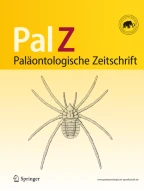Kurzfassung
Aus dem Kupferschiefer (Zechstein 1; Ober-Perm) des Richelsdorfer Gebirges (Hessen) werden Magen-Darm-Inhalte in Skelettresten des kleinen PareiasauriersParasaurus geinitzi und des archosauromorphen ReptilsProtorosaurus speneri vorgestellt. Diese Füllungen gehören zu den stratigraphisch ältesten bekannten Funden dieser Art bei landlebenden Tetrapoden. Der Magen-Darm-Inhalt des Fundes vonParasaurus besteht aus einer deutlich abgegrenzten Masse grobklastischen Materials mit beigemengten kohligen Teilchen. Das Vorkommen zahlreicher Samen der KonifereUllmannia frumentaria im Magen- und Darmbereich des hervorragend erhaltenenProtorosaurus-Fundes bestätigt die Auffassung von Weigelt (1930), daß Teile dieser Konifere einen Bestandteil der Nahrung dieses Reptils bildeten. In der Bezahnung vonProtorosaurus finden sich dafür allerdings überraschenderweise keine Hinweise.
Abstract
We report here on gut contents in partial skeletons of the small pareiasaurParasaurus geinitzi and the archosauromorph reptileProtorosaurus speneri from the Kupferschiefer (Zechstein 1; Upper Permian) of the Richelsdorf Mountains (Hesse). They represent two of the stratigraphically oldest known records of gut contents in terrestrial tetrapods. The gut content of the partial skeleton ofParasaurus comprises a distinct mass of coarse clastic material with interspersed carbonized particles. The occurrence of numerous ovules of the coniferUllmannia frumentaria in the gastric content of the excellently preserved new specimen ofProtorosaurus confirms the suggestion of Weigelt (1930) that portions of this conifer formed part of the diet of this reptile. Surprisingly, the dentition ofProtorosaurus does not reflect this dietary specialization.
References
Greene, H. W. 1982. Dietary and phenotypic diversity in lizards: Why are some organisms so specialized? - [In:]Mossakowski, D. &Roth, G. (eds.) Environmental Adaptation and Evolution: 107–128, Gustav Fischer, Stuttgart.
Haubold, H. &Schaumberg, G. 1985. Die Fossilien des Kupferschiefers. - Neue Brehm-Bücherei,333: 223 pp., A. Ziemsen, Wittenberg Lutherstadt.
Hotton, N., III. 1955. A survey of adaptive relationships of dentition to diet in North American Iguanidae. - American Midland Naturalist53: 88–114, Notre Dame, Indiana.
Kay, R. F. 1975. The functional adaptations of primate molar teeth. - American Journal of Physical Anthropology43: 195–216, New York.
Kellogg, R. 1929. The habits and economic importance of alligators. - United States Department of Agriculture, Technical Bulletin147: 1–36, Washington, D.C.
Koenigswald, W. V. 1980. Das Skelett eines Pantolestiden (Proteutheria, Mamm.) aus dem mittleren Eozän von Messel bei Darmstadt. - Paläontologische Zeitschrift54: 267–287, Stuttgart.
Lucas, P. W. 1979. The dental-dietary adaptations of mammals. - Neues Jahrbuch für Geologie und Paläontologie, Monatshefte1979: 486–516, Stuttgart.
Montanucci, R. R. 1968. Comparative dentition in four iguanid lizards. - Herpetologica24: 305–315, Lawrence, Kansas.
Olson, E. C.;Hotton, N., III &Beerbower, J. R. 1991. Wear of tetrapod teeth as indication of Lower Permian herbivory. - Journal of Vertebrate Paleontology11 (Suppl. to no. 3): 49 A, Lawrence, Kansas.
Richter, G. 1987. Untersuchung zur Ernährung eozäner Säuger aus der Fossilfundstätte Messel bei Darmstadt. - Courier Forschungs-Institut Senckenberg91: 1–33, Frankfurt am Main.
— 1988. Problems in the analysis of stomach contents of Eocene mammals from the Messel oil shale layers. -Courier Forschungs-Institut Senckenberg107: 121–127, Frankfurt am Main.
Schweitzer, H.-J. 1962. Die Makroflora des niederrheinischen Zechsteins. - Fortschritte in der Geologie von Rheinland und Westfalen6: 331–376, Krefeld.
— 1968. Die Flora des Oberen Perms in Mitteleuropa. - Naturwissenschaftliche Rundschau21: 93–102, Stuttgart.
Weigelt, J. 1928. Die Pflanzenreste des mitteldeutschen Kupferschiefers und ihre Einschaltung ins Sediment. Eine palökologische Studie. - Fortschritte der Geologie und Paläontologie6, Heft 19: 395–592, Berlin.
— 1930. Über die vermutliche Nahrung vonProtorosaurus und über einen körperlich erhaltenen Fruchtstand vonArchaeopodocarpus germanicus aut. - Nova Acta Leopoldina6: 269–280, Halle/S. Wild, R. 1985. Ein Schädelrest vonParasaurus geinitzi H. v. Meyer (Reptilia, Cotylosauria) aus dem
Kupferschiefer (Perm) von Richelsdorf (Hessen). - Geologische Blätter für NO-Bayern 34-35: 897-920, Erlangen.
Young, J. Z. 1981. The Life of Vertebrates. Third Edition. - XVI + 645 pp., Clarendon Press, Oxford.
Author information
Authors and Affiliations
Rights and permissions
About this article
Cite this article
Karlsruhe, W.M., Sues, HD. Gut contents ofParasaurus (Pareiasauria) andProtorosaurus (Archosauromorpha) from the Kupferschiefer (Upper Permian) of Hessen, Germany. Paläontol. Z. 67, 169–176 (1993). https://doi.org/10.1007/BF02985876
Received:
Issue Date:
DOI: https://doi.org/10.1007/BF02985876
